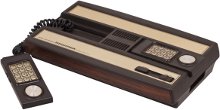 Atari 2600 Pal games are slower than the original Ntsc editions. This explains the unresponsive gampeplay of titles such as Moon Patrol, Galaxian or Super Breakout. |
|
Note: This article gives the
technical reasons for this loss of speed and presents the solution that
allows you to find the 100% original gameplay.
|
 |
 |
Who is impacted?
(Automatically translated into English) The origin of this loss of
speed goes back to the time when video standards were called Ntsc, Pal
and Sécam. This slowdown in the speed of the Atari 2600 affected the
entire Pal-Sécam area of the world (in green on the map opposite). The
reason is due to the frequency of screen scanning: in the United
States, where the Atari 2600 was born, cathode ray screens scanned 60
images per second, in accordance with the frequency of the territorial
electric current: this is the standard. NTSC (in red on the map
opposite). In most of Europe, Asia, Africa and Australia, screens
scanned 50 images per second, again because of the frequency of the
electric current: these are the Pal and Secam. With 60 frames per
second, against 50, the Ntsc games went 20% faster than those of Pal
and Sécam.
|
 |
|
These few contemporary consoles of the Atari 2600
do not pose the problem
of the speed difference
games depending on the region
(technical explanation opposite).

Odyssey Magnavox
and Philips Videopac (1978)

Mattel Intellivision
(1979)

CBS Colecovision
(1982)
|
Let's be more specific
(Automatically translated into English) Even if this is the origin
of the cause of the slowdown in the Pal and Sécam games, the facts
exposed so far are not sufficient to explain this slowdown. Indeed, the
other consoles, despite their various regionalizations do not present
this difference in frequency: whatever the region, the games go at the
same speed. So why the Atari VCS does it differently? Here's the
reason: unlike other consoles, the Atari 2600's GPU does not have video
memory, so it has to draw on the screen, while the CRT electron gun
scans. . As a result, during the entire display of the screen, the
program is fully occupied in drawing the image and this, at a rate of
60 times per second in Ntsc (and 50 times for a game in Pal version and
in Secam) . It is only after having swept the whole screen that the
program can take care of the management of the events (observation of
the joystick, movement of the sprites, increment of the score, etc.)
which is done, again 60 times. per second in Ntsc and only 50 times in
Pal, as well as in Secam. It is precisely this last point, the
frequency of event management, which produces a decrease in speed
between Ntsc games and Pal-Sécam games.
|
 |

To identify the Pal versions,
a P is printed on the edge
cartridges, to the right of the game title.

Subsequently, the label no longer
has the P and thus becomes
similar to NTSC versions.
Pal identification is now done
by a label stuck on the back.
|
Two variations per game
(Automatically translated into English) Obviously, for a game to
work well, the program must be adapted according to the scanning
frequency of the target country. The Atari games were therefore
designed by the developers in two versions. The first was adapted to
the NTSC standard at 60 frames per second. The second was a 50 fps
conversion, with slower gameplay. This second version, dedicated to Pal
territories, was marked with a "P". At the beginning it appeared on the
edge of the cartouche, next to the title (see opposite). Later, it was
found marked on a label stuck on the cartridges (and sometimes on the
cardboard boxes). Due to their common frequency of 50 Hz, Pal consoles
and Sécam consoles use the same cartridges. This is why in France, our
Atari cartridges are marked with a "P" although the French standard has
been Sécam.
|
 |

|
What if we are wrong?
(Automatically translated into English) Rest assured, if you put a
cartridge of a video standard (Ntsc, Pal or Secam) in a console of
another standard, your console will not explode. On the other hand, you
will get amazing colors, as in the case of Pitfall (see this article).
In rare cases, if you are using a very old television, you will have a
black and white image (remember to activate the "Color / black &
white" button, as this sometimes suffices to circumvent this problem).
|
 |

|
For the best Gameplay!
(Automatically translated into English) With current multistandard
screens, capable of supporting all kinds of scanning frequencies, it is
possible to operate cartridges of different frequencies (50 or 60 Hz)
on consoles of NTSC, Pal or Sécam standards. Whatever your console, all
you have to do is find your favorite NTSC original edition game to
enjoy the best gameplay on Atari 2600. Even if the colors do not
necessarily match, the Gameplay will be on top!
|
 |
|
|